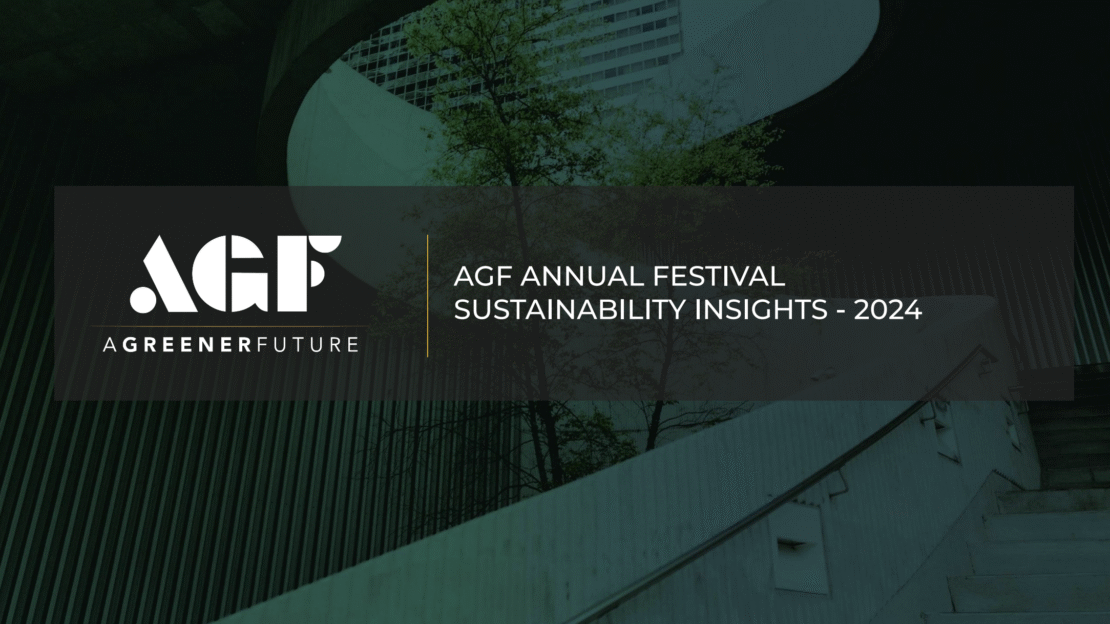The A Greener Future (AGF) Festival Insight Report, reviews sustainability practices from the 40 music festivals that took part in the A Greener Future (AGF) certification scheme in 2024. The report provides a snapshot of some of the evolving trends in energy use, water consumption, waste management, food & drink, and transport. In this guest blog, Alex Fintoni, Carbon Analyst at AGF, gives a breakdown of the key findings and updates from the report. Read the article below:
A Greener Future (AGF) has been assessing festival impacts worldwide for 20 years, and publishes industry insight reports outlining progress, innovation and areas for improvement within the sector. The AGF certification follows the AGF framework, a holistic approach through which to understand and manage sustainability.
AGF Sustainability Framework

The 2024 Festival Insight Report, focusing on 40 music festivals taking part in the AGF certification scheme, provides a snapshot of some of the evolving trends in energy use, water consumption, waste management, food & drink, and transport.
Overall, this year’s data demonstrated some positive trends:
- 70% of assessed events implemented a complete ban on single-use plastics,
- The average site recycling rate increased from 38% in 2022 to 49% in 2024,
- 70% separated out biodegradable waste for composting or anaerobic digestion,
- 20% of festivals assessed were either fully vegetarian or vegan, compared to only 8% in 2023,
- Over 80% had a sustainable food and beverage policy or charter.
It is particularly encouraging to see food and beverage sustainability becoming a key focus. The quality of food & beverage options now available to festival-goers has greatly improved in recent years, with a growing emphasis on local producers and brands, and providing a larger variety of food options.
However, as the range and quality of food offerings has increased, so has our understanding of the overall impact of our food systems. Analysis of festival carbon footprints by AGF, and confirmed by other studies within the sector, found that F&B is frequently the second largest source of emissions after transport. This understanding also presents opportunities for festivals to not only take direct actions with traders or suppliers, but also to actively engage with audiences around food sustainability. For example, We Love Green in France are using their food court as a key attraction and a means of introducing audiences to vegetarian food, working with guest chefs to highlight the multiple ways sustainable dishes can be enjoyed.
In terms of energy use, we did see a growing number of events using renewable energy and battery systems for the first time, but generators remain the main source of power for the majority of events. Only a quarter of festivals assessed were powered entirely by grid electricity, with diesel fuel still widely used by small to medium festivals, while larger events have mostly transitioned to HVO fuel. The transition to HVO should also be seen as a stepping stone rather than an end in itself. Whilst considered preferable to diesel fuel, it remains a source of air pollution, and recent reports have highlighted limitations to the sustainability and transparency of HVO supply chains.
A broader transition away from generators will likely remain a challenge until battery systems, grid connections, and other low-carbon power systems become more available and affordable. Specific research into the energy challenges of UK festivals was also undertaken by AGF in 2024 as part of the Low Emissions Festival Report.
Finally travel and transport remains, as always, the major source of carbon emission across all festivals, albeit with significant variations. Audience travel emissions were found to represent on average between 35% and 94% of festival carbon emissions, depending on the location, nature, and scale of the events. Broader travel as a whole (including artist travel, production and freight transport, etc.) was typically responsible for 67% to 97% of an event’s carbon footprint.
Yet 2024 also saw the release of several exciting studies, trials, and initiatives seeking to reduce the impact of travel and transport:
- The Massive Attack ACT1.5 concert and the Liverpool Accelerator City event explored methods to increase the share of local and regional audiences through regional pre-sales and integrated travel and concert tickets, as well as additional trains and shuttles.
- The Changency “ticket to ride” project analysed how artists and promoters can influence and incentivise audience low carbon travel.
- The Green Room “Landscape” study (FR) studied how venue size impacts audience travel behaviour, outlining opportunities for action.
- The Fuel Project explored decarbonisation pathways for supplier transport and power within the Film industry.
Despite the recent trends seeking to limit climate change action, the festivals and events sector continues to demonstrate that it is a space driving sustainable innovations, engagement, and action.
To read the full Festival Insights 2024 report sign up to A Greener Future for free access HERE.
To participate in the AGF certification or Sustainability Diagnosis, and contribute to further annual industry insights, contact hello@agreenerfuture.com

